It all started with a contact with the range of Volkswagen Commercials, for the first time I was driving the van of this brand. In other occasions I have driven Citroën Jumpy/Fiat Scudo, Ford Transit and Renault Trafic, so I have something to compare with in the same category. In a parallel universe I'm sure I'm a van driver, because I confess that these things give me morbid curiosity.
After testing for a couple of hours the mid-range passenger version - Caravelle - I drove a van, but not just any van. It was love at first sight, I saw it and I wanted it. When I finished driving it, I asked to borrow it for a longer test drive, and so it happened. After having driven more than 1,000 kilometres with the new Transporter range, I think I can show you a proper test.
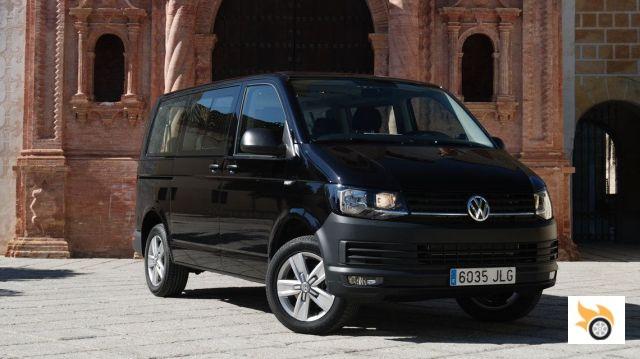
Design
On the one hand, I drove a Caravelle, with eight seats and a lot of extras. Within the Transporter range we have several levels, starting with the Kombi/Mixto for working people, the Caravelle as an alternative to a large MPV, and the Multivan for more premium uses, as a hotel shuttle vehicle. The California deserves a separate mention, a version for adventurers and campers, which doesn't need much introduction.
I've been looking over the last few weeks at the differences between the different Transporters of the last three generations, and the design is remarkably similar. It's instantly recognisable, even more so than a Golf or Polo. From a distance you know you're looking at a Transporter, the only question is what year. You have to look at the bumpers, grille and light clusters - as well as the number plate - to be sure.
The T6 generation is actually a major update of the T5 generation, which has been on the market since 2003.
That's why the design seems so continuist, something that, on the other hand, works very well for Volkswagen in general. The load capacities are the same as in the T5 generation, and there are no changes in terms of interior design. Consequently, any interior fittings are valid for T5 and T6, indistinctly. In short, it is an update in terms of design (exterior and interior), more modern engines, some improvements in terms of quality/equipment, and more advanced safety and infotainment systems.
To distinguish the T6 generation of the T5, we have to look at the front, more angular, and follow it visually to the bottom. At the rear we will see that the width is better perceived by the horizontal molding, and that the license plate is in a lower position. From the side, the mirrors are a little lower, and the indicators are included inside the moulding. This moulding marks the limit of the two-tone paint, if there is one.
The Caravelle we tested has a dark colour, with 17″ Devenport alloy wheels (worth almost 2,000 euros) and a black, plastic bumper. It's a simple model, the Trendline, with the mirrors and door handles in black plastic as well. With a few extras you can get a really attractive result, as is the case of the tested van. I swear that more people have asked me about the van than about any other "exotic" car I've owned recently.
The first thing I thought when I saw it was "what a beautiful van". It has the bumper painted in the color of the body, which by the way, has a dual Candy White and Cherry Red (an option, and expensive). It also has body colored mirrors and door handles, and the jewel in the crown: the 18″ Disc wheels in white. How could I not like them...
The van has paneled sides, and comes standard with dual tailgates, although this unit has a single tailgate that opens 90 degrees upwards. Despite being a cargo version, it has a centre mirror and a gap to see through the bulkhead and tailgate. So the driving feel was more like a large SUV or minivan, rather than a simple commercial. If you want, a second side door is available, but you can get by just fine with the right one.
The two versions tested have the same exterior size, i.e. short wheelbase and low roof, and the ground clearance is the same.
The tested version of the van has a short wheelbase and low roof, so we have a class-leading load capacity of 5.8 cubic metres, or 4.3 square metres. For example, the Renault Trafic, Opel Vivaro and Fiat Talento have 0.6 m³ less in their equivalent model (L1H1). The outgoing generation of PSA/Fiat vans, i.e. Citroën Jimpy, Peugeot Expert, Fiat Scudo and Toyota Proace are down to 5 m³ in their van or coupé configurations (only with white paintwork).
As for the Caravelle, with the standard 8-seater configuration (2-3-3), folding down the third row, the boot capacity is 3.5 m³. There are mums and dads who measure the space needed not for human babies, but for baby elephants. In those 3,5 m³ you can fit prams, bathtubs, baby walkers, the complete winter/summer clothes and whatever else you can think of. After all, the Caravelle is also an alternative to a large MPV, as is the case with the Sharan, if we stay within the brand.
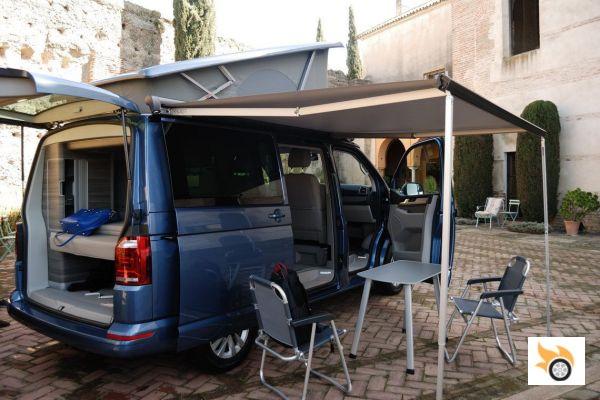
The standard wheelbase is 3 metres, and the long wheelbase is 3.4 metres. In the first case we are talking about a total length of 4.89 meters, in the second, 5.29 meters. As for the height, the standard height is 1.97 meters, with the medium roof 2.17 meters, and with the high roof, 2.47 meters. It should also be noted that the Transporter has the standard ground clearance, the Multivan goes 20 mm closer, and with dynamic chassis (pity that the van did not have it) lowers 40 mm. You can also order a raised ground clearance for driving on goat tracks (Seikel chassis).
Before continuing, let me tell you briefly about the California, which is the "Camper" version of the Transporter. There are two versions, California Beach and California Ocean. The first is basically a passenger Transporter with a roof that lifts up and houses a bed, and the second is a compact motorhome. The images correspond to a California Ocean with all kinds of "goodies", more than 60,000 euros of junk. They are expensive new, and used too. They don't go down in price as much as a used commercial.
The unit in the photos, which was available at the presentation, has four seats, two beds, gas stove (can be alcohol), fridge, folding table, wardrobe and even a shower for outdoor use. There is also a fresh water tank and a grey water (waste) tank. There are extras to suit all budgets, such as stationary heating. For the same price you can have a larger, but less luxurious motorhome.
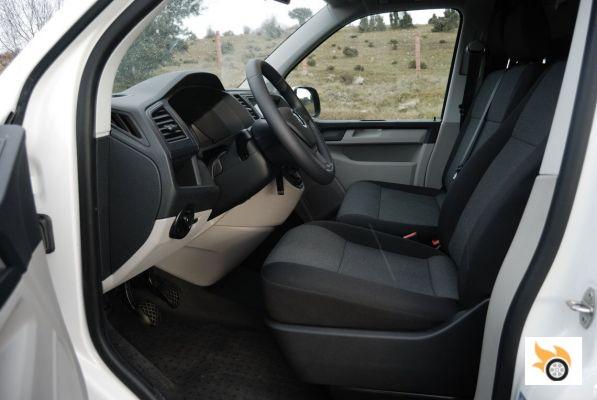
Cab
The van is the sportiest of the range, with three seats in the passenger compartment: pilot, co-pilot and fear. Optionally, the "roadster coupé hardtop" version comes with only two seats. You can see that the dashboard of the industrial version (left image) has less noble and more plastic materials than those of the Caravelle (right image). The van has a simpler, plastic steering wheel, but it is something you can live with every day without problems. The gear knob also shows a difference in quality.
The driving position is high, without barely raising the knees, the closest thing to being in a comfortable chair. We have more ground clearance than the SUVs, whose drivers we can look over our shoulders, as we are a breed apart, of a higher range. You can look defiantly at the owner of a Touareg and think: "Ha! (*) For a lot less money, I've got a much bigger car than you".
I only have one relevant drawback, that the light control is in a position that forces you to remove your back from the seat, or I'm just badly made. Otherwise, I found it very comfortable, there was even adjustable height for the seatbelt. In the Caravelle there is more freedom to adjust the length of the seat as there is no bulkhead separating it from the cargo area. The passengers who have been with me as rall... sorry, as passengers, have spoken very highly of the seats.
NOTE: "Ja" means "yes" in German.
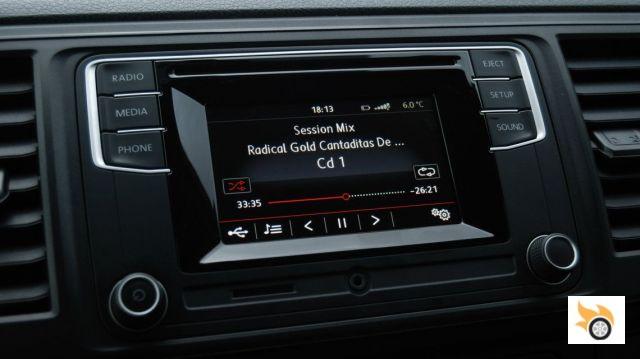
The acoustic comfort is very good for a van, both the Transporter and the Caravelle are very quiet for this category. We're talking about completely normal levels for a normal van of a similar size. The heating works very well, even if the fan is off, I was quite comfortable even on cold days. The Caravelle can have a triple zone climate control.
I love the driving position. Like the Mazda MX-5, there's an air vent facing each hand, the pedals are close together for easy toe-tapping, and the gearshift knob has very short, mechanical strokes. I've driven several minivans that didn't have this level of quality and appreciation for pure driving. The basic steering wheel has no satellite controls to get in the way, so we can concentrate exclusively on the road and the lines.
The rest of the controls, except for the lights, are well positioned, and the storage compartments -several with rubber bottoms- are within easy reach. The stereo, too, which, by the way, sounds much better than you'd expect in a van. That's how I ended up playing the 2003 Radical Gold -Cantaditas de colección-, with the right rhythm to tame those 140 hp of power. Even with the "volts" turned up high, there are no annoying vibrations in the dashboard or door panels. The touch screen has a detail that I loved, it recognizes the keystrokes when driving with gloves on! As I write these lines I miss the van more than my last ex.
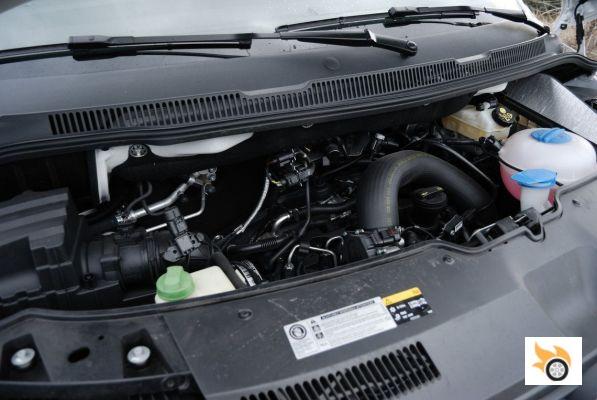
Technology
All engines in the Volkswagen T6, whatever it's called, are four-cylinder, two-litre engines. The petrol range is made up of the 2.0 TDI between 84 and 204 hp, in the case of passenger versions they are all already Euro 6 with selective catalytic reduction (SCR), while the industrials still use Euro 5 engines without SCR, and NOx emissions are higher, the specialty of the house. Specifically, the Caravelle tested had the 150 hp 2.0 TDI, and the van had the 140 hp. They let me have the 204 bhp Bi-TDI and I'd run out of points on my licence before I had to return it.
The TDIs are positioned on the front axle with a positive camber of 8 degrees, as you can see in the photo of the body, they haven't broken the horns with covers to make it nicer, but it's properly insulated. The diesel engine is no more annoying than it is in any MPV, relatively refined unless you're very particular. There are petrol versions with up to 204 bhp, and you can equip it with DSG automatic transmissions and even 4MOTION all-wheel drive. The milk.
The power steering is hydraulic, so it has a more realistic feel than many modern cars that use electromechanical. For the next generation it will probably be changed to save fuel. The suspension has a typical "hot hatch" layout, McPherson front and torsional axle at the rear. You can have magnetic suspension adjustment: normal, comfort and sport. This last one is no joke, I swear by my mother.
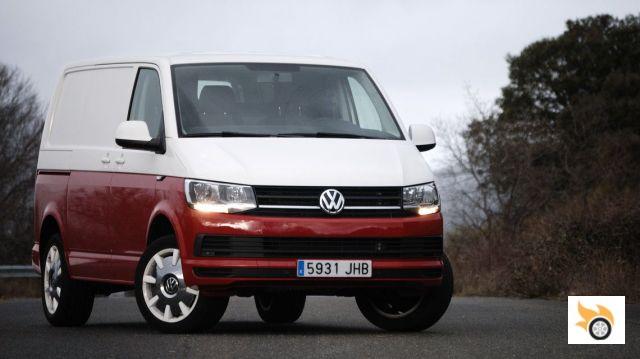
Driving
I drove the first kilometres with the T6 generation in an empty Caravelle, i.e. with a kerb weight of around 2.1 tonnes. Like SUVs, it weighs like the mother who gave birth to it, composite materials are not yet in vogue in this type of vehicle. It was like taking a minivan, very comfortable, the kilometers can be devoured by hundreds and get off fresher than a rose at the end of the trip. The tyres of the test unit are Bridgestone Turanza ER300, very suitable for general use. It can even be ordered with "all year" tyres.
At around 100 km/h, the computer can give instantaneous fuel consumption similar to that of a saloon or compact SUV.
The van version has a more "racing" feel, as it has the weight reduction kit (without the rear seats), as well as the covert sports package: registration as a passenger car and speed limits of a passenger car. According to the technical data sheet it doesn't go over 173 km/h, because of the two-tone paint, if it is completely white it will surely reach 200 km/h and beyond. On the other hand, let no one lose sight of the 18″ ContiSport Contact 3 tires, sporty type, in dimensions 255×45 R18. No joke, they're put on performance sedans and compacts, they're UHP.
I've always thought that it makes no sense to test a commercial vehicle when it's empty, it's like testing a Nissan GT-R driving in driving school style, so part of the test was done with the Transporter loaded to the roof, making use of refined Russian loading algorithms (come on, pure and simple Tetris). The images can attest that I'm not talking about another literary or humorous figure. There was no room for a pin in there.
First test of fire, up the ramp of a garage, 18 degrees, without torturing the clutch, and without abruptness so as not to break anything of the load. Test passed, the 340 Nm of the engine made the Transporter go up loaded at the first time. I couldn't say how much weight I had put in the compartment, but I don't think it was less than 500 kilos. The necessary power, without a big engine (in the past this was achieved with 2.3, 2.5 or even 3.0), in the balance is the virtue.
Driving with a full load, I drove the same way as if I had an uncapped Starbucks coffee cup (magma temperature) between my legs, so as not to spill a drop or a tear. There's no need to play with that thing called center of gravity, although the heaviest part was placed near the floor for obvious reasons. The engine is only a bit lazier, but it has enough balls to go 140 on the highway in sixth gear, although my trot was more like 100-120 km / h. And consumption didn't shoot up exactly. And the fuel consumption didn't shoot up, it was still within very reasonable limits.
It recovers from 80 to 120 km/h in fourth gear in just 8.7 seconds, almost catching the Hyundai i30 Turbo.
Everything has a limit, the engine starts to fall short if you want to recover speed quickly after 120 km / h, as the aerodynamics in this type of vehicle is not prodigious to say. Hardcore van owners will appreciate the 204 hp TDI, and I'm sure the Guardia Civil and their dataphones will too. Overall, the power of the unit tested is fine for general and even demanding uses. I don't think that with 84 hp it would have been able to go so light, but of course, not everyone has the same load needs.
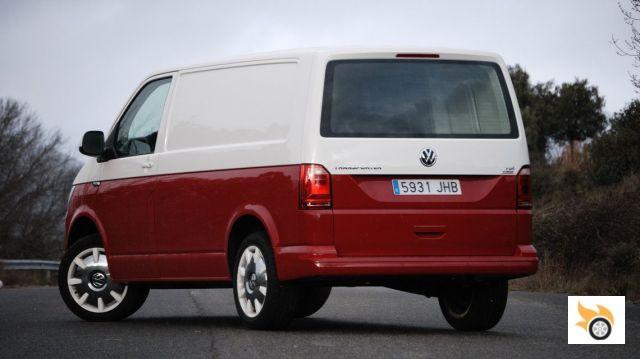
The suspension didn't become torturous despite the weight increase, and it didn't lower the body to a stop either. The photos attest to that, you only have to look at it. You can look defiantly at the owner of a Touareg and think: "Ha! It's much heavier than you". Driving vans in the same segment of the competition, I did notice the difference between being loaded and going in SL or "sport leicht" mode.
Most of the test was done with the cargo compartment empty, fully loaded I did about 100 kilometers. And how long does the tank last? Well, an eternity, 927 kilometers at the time of delivery and without the reserve light going off, with autonomy for another 160 km. If I said that I was driving efficiently and thinking about the tank life, I'd be lying through my teeth. Even so, it was under 8 l/100 km real, the homologation matches, miracle!!! The averages according to the computer have danced between 7.2 and 7.9 l/100 km, the van at equal trot and load sucks a little less, because of the seats, insulation and other stuff it doesn't have.
In extreme pesetor driving you can make averages close to 5 l/100 km. And the computer is quite accurate...
When driving unladen, you have to be careful with acceleration in first gear, it's relatively easy to slip the wheels, luckily there's stability control (which can be switched off for mischief or driving on snow). To be honest, I'd love to see what happens with the 204 hp TDI, all-wheel drive, and a drag race type start, I'm sure I'd weld the back of my head against the headrest.
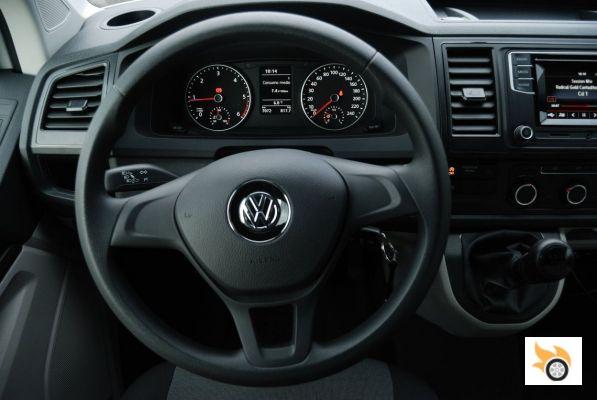
But this is Pistonudos and I can't fail to mention the Transporter's sporty driving behaviour. I drove the Caravelle on a route where the most dangerous corner was a roundabout, but with the Transporter I was happy. It's surprising how fast it can go and how confidently it tackles fast corners, although it warns early on that there's inertia and it's a good idea to lift your foot a little before the mid-point of the corner. The tyres grip like Charlton Heston to his rifle, part of the merit comes from there.
If we mash the throttle in slow corners, we will notice that there is skidding on a wheel in the absence of self-locking differential, so you have to dose the throttle with love to be really fast. The engine has a lot of power. I wouldn't have dared to drive as spiritedly as the Transporter with some of the competition's vans, although I must admit that the Jumpy VTR Coupé (in white) copes very well with my favourite mountain pass. As a good front-wheel drive, if you're a good Filipino, you can humiliate a much more powerful car, as the Leon Cupra R or the Mégane RS Trophy R do.
Thanks to the Stop&Start function, you'll avoid the temptation to rev the TDI at idle at traffic lights, although it can be switched off.
This really is a sporty SUV, in some conditions it can give the same confidence as an Audi Q7, there are cars of this size and weight that are much more clumsy and that incite to ask for calm in less time. With the Transporter, you can forget that you are driving a van, even perceive that I don't know what, that what do I know, we call pistonudo factor. I enjoyed every mile I drove with this thing. If one day I am blessed with a large family, four children or more than one "shot", I will pass SUV, I'll probably get one of these.
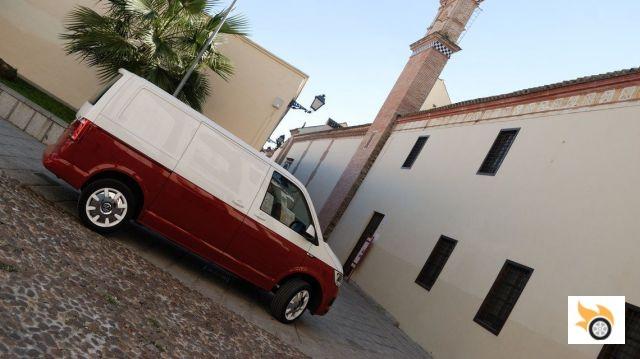
Conclusions
Although the test is written in a very relaxed and pleasant tone, because otherwise you won't read the whole test of a commercial, practically everything is real, only the way of saying it changes. It is not only a work vehicle or cargo mule, it is also a very pleasant vehicle to drive, and supports a very typical tourism driving. Of all the vans I've tested, it's the sportiest, even though it didn't have the best suspension setup for that use. With the lowered chassis and adaptive suspension, the only thing missing is the "R" badge on the tailgate.
I wasn't able to test the various safety systems that are available for the T6 generation, such as radar cruise control with automatic braking, fatigue monitor, or automatic light assistant. All of those are optional. In fact, if we go into the configurator, we're going to have a good time with the beastly amount of options there are. It's like in a Premium brand, you can start adding equipment and see a final price figure that stops the cancer by instant heart attack. Oh, and notice that the configurator can be desperate as we choose an option incompatible with another.
Transporter, Caravelle, Multivan or California, it's the same, the T6 generation does not pretend to be the cheapest in the segment, and it shows what one spends thousands of euros more on cheaper competitors. This explains the residual values and the condition of the Transporters of the T3 and T4 generation. If I was looking for a vehicle in this class, I would probably not have looked for alternatives any more, I would have been convinced by this one.

























